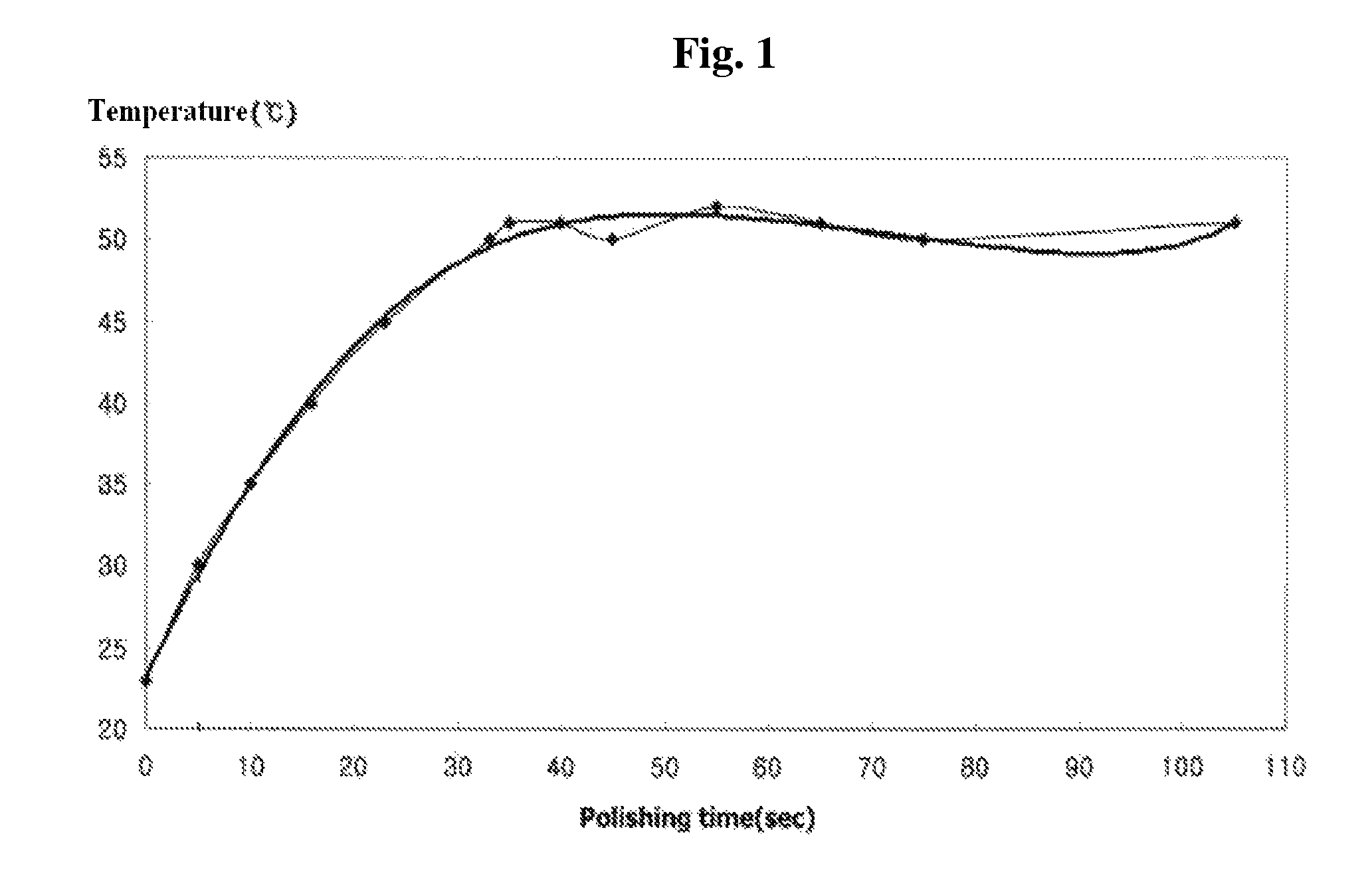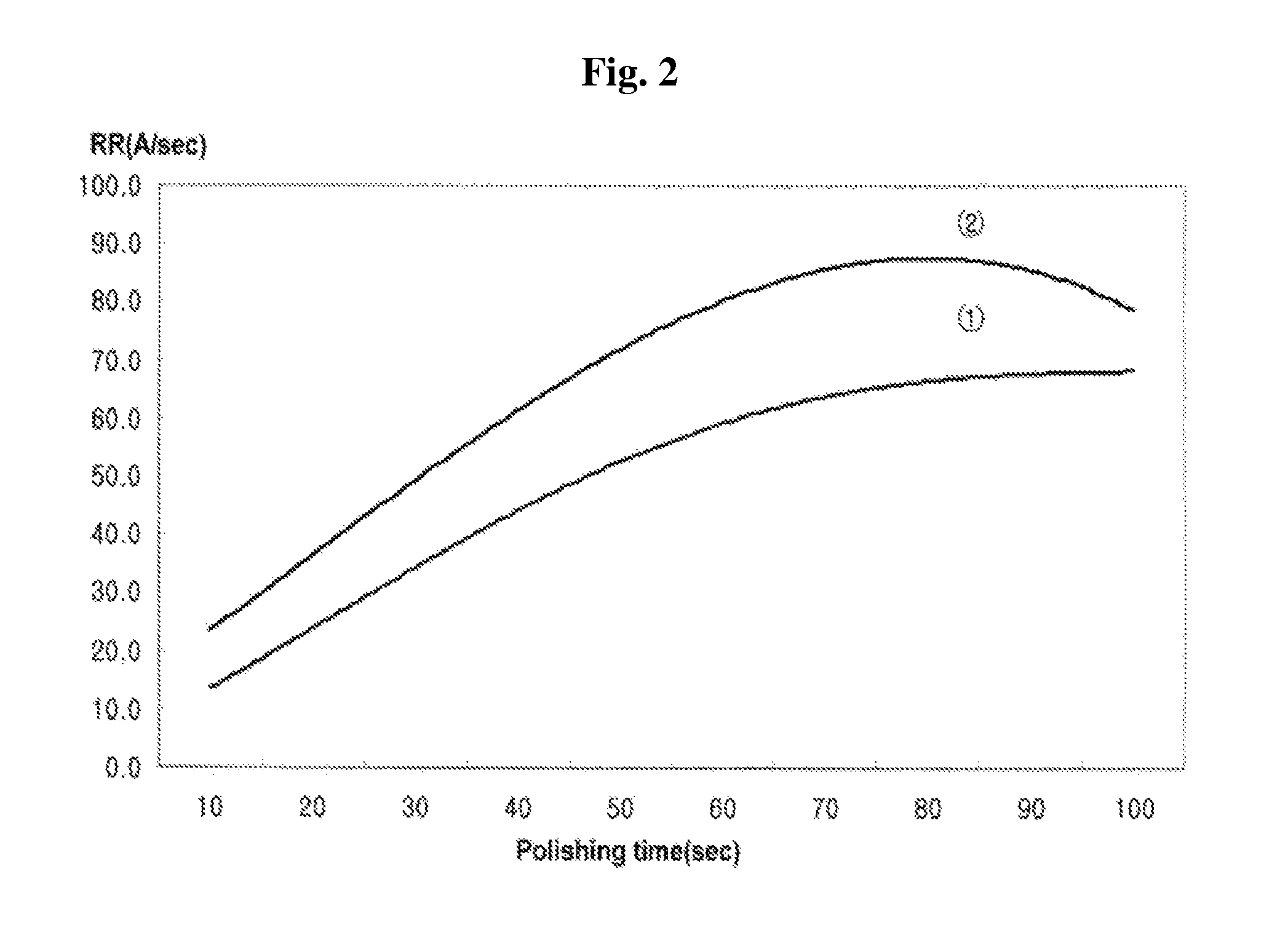Chemical mechanical polishing slurry composition including non-ionized, heat activated nano-catalyst and polishing method using the same
- Summary
- Abstract
- Description
- Claims
- Application Information
AI Technical Summary
Benefits of technology
Problems solved by technology
Method used
Image
Examples
examples 19 to 21
Tests for Polishing Performance of Metal Silicides (MSi) with Different Transition Metals
[0047]The polishing performance of ferrosilicon and metal silicides (MSi) with different transition metals was comparatively tested, and the test results are shown in Table 4 below. As can be seen from the results in Table 4, the removal rate of the tungsten substrate in the cases of manganese silicide and cobalt silicide was reduced compared to the case of nano-ferrosilicide, but the polishing function thereof could be confirmed. Accordingly, it could be found that other transition metal silicides such as manganese silicide and cobalt silicide, in addition to ferrosilicide as the non-ionized heat-activated nano-catalyst, also belong to a class of non-ionized, heat-activated nano-catalysts which release electrons and holes by energy generated in chemical mechanical polishing processes.
[0048]The polishing performance tests were carried out using the same polishing machine, method and conditions a...
experimental examples 1 to 3
Experiments of Reactivity by Thermal Energy
[0050]To examine the reactivity between the oxidizing agent (hydrogen peroxide) and the catalyst, 3.0 wt % of the oxidizing agent was added to each of an aqueous solution containing pure deionized water and 0.0017 wt % of nano-ferrosilicon (Fe content: 8 ppm) as the non-ionized, heat-activated nano-catalyst according to the present invention, and an aqueous solution containing 0.0434 wt % of ferric nitrate ((Fe(NO3)3; Fe content: 60 ppm) as the prior catalyst, and the states (the change in color caused by reaction with the oxidizing agent, and the generation of bubbles) of the aqueous solutions were observed. Also, the aqueous solutions were heated to 60° C., and the oxidizing agent was then added thereto, after which the states of the aqueous solutions were observed. The observation results are shown in Table 5 below.
[0051]
TABLE 5Imme-diatelyWithinBeforeAfter Immediately30 AdditionAdditionAfterminsofofHeatingAfterOxidizingOxidizing toHeati...
experimental example 4
Relationship Between Polishing Temperature and Removal Rate
[0053]In order to examine the relationship between polishing temperature and removal rate, a wafer having a 8,000 Å-thick tungsten (W) CVD (chemical vapor deposition) film coated thereon was polished using a CMP system (FREX-200, Ebara, Japan) and the chemical mechanical polishing slurry composition of Example 7. The change in the temperature of the surface of the pad (IC 1000, Rohm & Haas, USA) during the polishing process was measured by using an IR sensor (SK-8700; SATO, Japan) to detect the temperature of the pad surface closest to the CMP head, and the measurement results are shown in FIG. 1. As can be seen in FIG. 1, after about 30-40 seconds after the start of polishing, the polishing temperature increased to and was maintained at about 50° C.
[0054]In addition, the removal rate (Å / sec) of the W film according to polishing time (sec) was measured, and the measurement results are shown in FIG. 2. In FIG. 2, “①” is remov...
PUM
| Property | Measurement | Unit |
|---|---|---|
| Temperature | aaaaa | aaaaa |
| Particle size | aaaaa | aaaaa |
| Volume | aaaaa | aaaaa |
Abstract
Description
Claims
Application Information
 Login to View More
Login to View More - R&D
- Intellectual Property
- Life Sciences
- Materials
- Tech Scout
- Unparalleled Data Quality
- Higher Quality Content
- 60% Fewer Hallucinations
Browse by: Latest US Patents, China's latest patents, Technical Efficacy Thesaurus, Application Domain, Technology Topic, Popular Technical Reports.
© 2025 PatSnap. All rights reserved.Legal|Privacy policy|Modern Slavery Act Transparency Statement|Sitemap|About US| Contact US: help@patsnap.com



